[SOLVED] DAS Part 1
VerifiedAdded on 2021/04/16
|16
|4458
|190
AI Summary
The DAS Part 1 assignment is a comprehensive report that requires the student to assess their background, characteristics, and unique needs. The student must provide detailed descriptions of three error patterns, including narrative and hypotheses. Additionally, the student must describe informal ways used to test their hypotheses about the errors identified and document this process. The student must also include documentation copies attached, graduate-level writing, a measurable goal included in the IEP, and use the DAS template to report the assessed understanding and skills addressing in narrative each component area for their student with a Generalist disability.
Contribute Materials
Your contribution can guide someone’s learning journey. Share your
documents today.

Running Head: DATA ANALYSIS SHEET 1
DATA ANALYSIS SHEET
Name:
Institution:
Course Code:
DATA ANALYSIS SHEET
Name:
Institution:
Course Code:
Secure Best Marks with AI Grader
Need help grading? Try our AI Grader for instant feedback on your assignments.
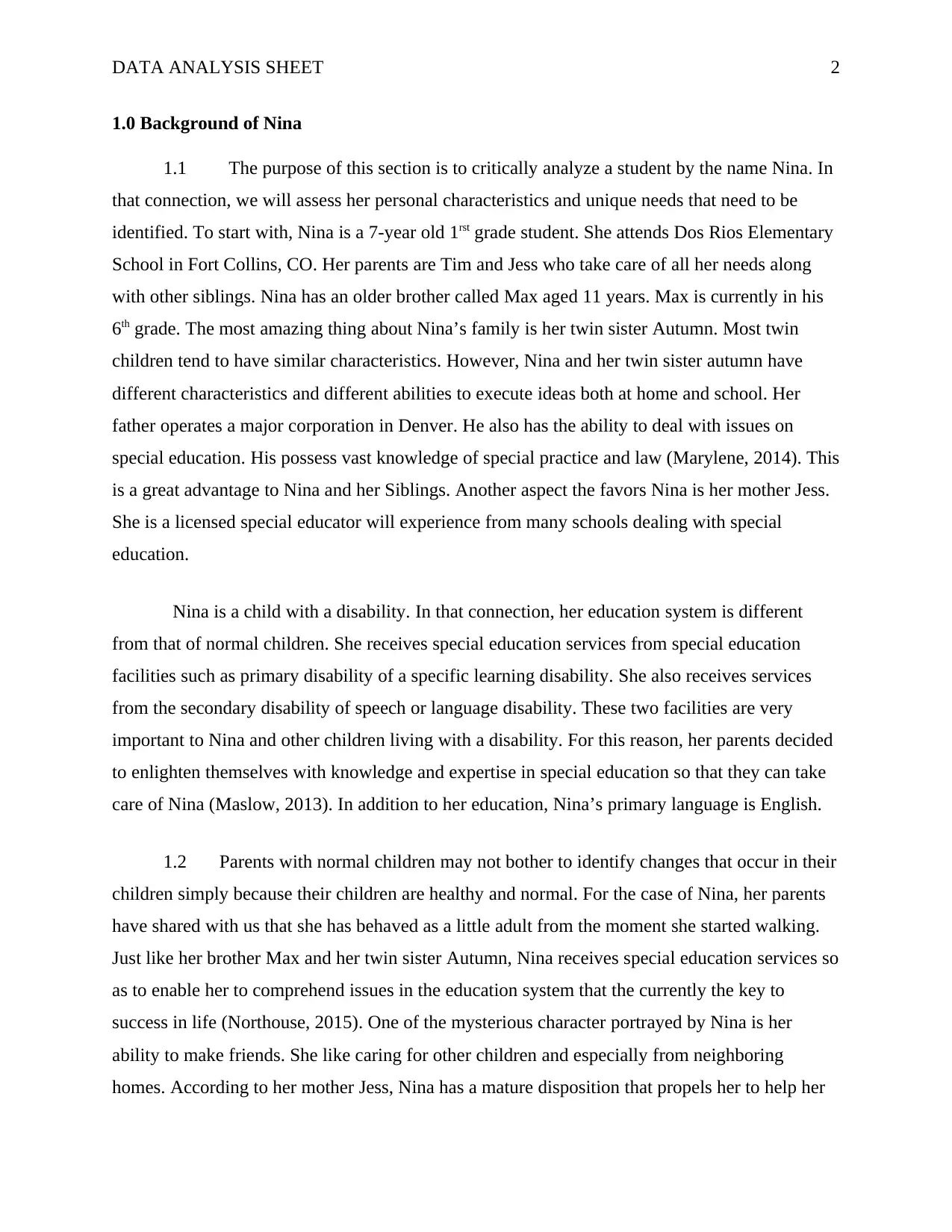
DATA ANALYSIS SHEET 2
1.0 Background of Nina
1.1 The purpose of this section is to critically analyze a student by the name Nina. In
that connection, we will assess her personal characteristics and unique needs that need to be
identified. To start with, Nina is a 7-year old 1rst grade student. She attends Dos Rios Elementary
School in Fort Collins, CO. Her parents are Tim and Jess who take care of all her needs along
with other siblings. Nina has an older brother called Max aged 11 years. Max is currently in his
6th grade. The most amazing thing about Nina’s family is her twin sister Autumn. Most twin
children tend to have similar characteristics. However, Nina and her twin sister autumn have
different characteristics and different abilities to execute ideas both at home and school. Her
father operates a major corporation in Denver. He also has the ability to deal with issues on
special education. His possess vast knowledge of special practice and law (Marylene, 2014). This
is a great advantage to Nina and her Siblings. Another aspect the favors Nina is her mother Jess.
She is a licensed special educator will experience from many schools dealing with special
education.
Nina is a child with a disability. In that connection, her education system is different
from that of normal children. She receives special education services from special education
facilities such as primary disability of a specific learning disability. She also receives services
from the secondary disability of speech or language disability. These two facilities are very
important to Nina and other children living with a disability. For this reason, her parents decided
to enlighten themselves with knowledge and expertise in special education so that they can take
care of Nina (Maslow, 2013). In addition to her education, Nina’s primary language is English.
1.2 Parents with normal children may not bother to identify changes that occur in their
children simply because their children are healthy and normal. For the case of Nina, her parents
have shared with us that she has behaved as a little adult from the moment she started walking.
Just like her brother Max and her twin sister Autumn, Nina receives special education services so
as to enable her to comprehend issues in the education system that the currently the key to
success in life (Northouse, 2015). One of the mysterious character portrayed by Nina is her
ability to make friends. She like caring for other children and especially from neighboring
homes. According to her mother Jess, Nina has a mature disposition that propels her to help her
1.0 Background of Nina
1.1 The purpose of this section is to critically analyze a student by the name Nina. In
that connection, we will assess her personal characteristics and unique needs that need to be
identified. To start with, Nina is a 7-year old 1rst grade student. She attends Dos Rios Elementary
School in Fort Collins, CO. Her parents are Tim and Jess who take care of all her needs along
with other siblings. Nina has an older brother called Max aged 11 years. Max is currently in his
6th grade. The most amazing thing about Nina’s family is her twin sister Autumn. Most twin
children tend to have similar characteristics. However, Nina and her twin sister autumn have
different characteristics and different abilities to execute ideas both at home and school. Her
father operates a major corporation in Denver. He also has the ability to deal with issues on
special education. His possess vast knowledge of special practice and law (Marylene, 2014). This
is a great advantage to Nina and her Siblings. Another aspect the favors Nina is her mother Jess.
She is a licensed special educator will experience from many schools dealing with special
education.
Nina is a child with a disability. In that connection, her education system is different
from that of normal children. She receives special education services from special education
facilities such as primary disability of a specific learning disability. She also receives services
from the secondary disability of speech or language disability. These two facilities are very
important to Nina and other children living with a disability. For this reason, her parents decided
to enlighten themselves with knowledge and expertise in special education so that they can take
care of Nina (Maslow, 2013). In addition to her education, Nina’s primary language is English.
1.2 Parents with normal children may not bother to identify changes that occur in their
children simply because their children are healthy and normal. For the case of Nina, her parents
have shared with us that she has behaved as a little adult from the moment she started walking.
Just like her brother Max and her twin sister Autumn, Nina receives special education services so
as to enable her to comprehend issues in the education system that the currently the key to
success in life (Northouse, 2015). One of the mysterious character portrayed by Nina is her
ability to make friends. She like caring for other children and especially from neighboring
homes. According to her mother Jess, Nina has a mature disposition that propels her to help her

DATA ANALYSIS SHEET 3
family members whenever she finds it necessary. This also motivates her brother and twin sister.
Nina possesses several characteristic and strengths which motivates her to achieve her
very best in her education. First, Nina is a friendly girl and she enjoys being a helper. Her parents
asserted to the team that she enjoys helping family members with activities at home. He also
enjoys helping other children at school and at home. Majority of neighboring children like being
associated with Nina due to her friendship and desire to assist them (Puttee, Vitale & Laing,
2011). This fact proves that Nina is much responsible as compared to her peers. Being
responsible beyond her peers make her peers to have trust in her. They tend to strengthen
friendship with her so as to benefit from her responsible traits.
1.3 Another important trait that Nina display is her devotion to her studies. Her
parents told the team that she spends much of her time in education programs and studies.
Everything she attempts is based on knowledge achieved through education (Richard, 2013).
Nina enjoys reading and computing mathematical problems. She also requested her parents to
invite a tutor who would assist her in her studies. This is a clear indicator that Nina is devoted to
her studies.
As much as she knows much than her peers, Nina is always ready to learn new ideas in
her education system. The desire to learn propel her in discovering new information. She may
end up innovating new skills in her educational journey. Again, Nina has a special talent for
promoting love and compassion. She enjoys helping others out of a sense of love and
compassion. This characteristic is a clear indicator that she is motivated intrinsically. Through
intrinsic motivation, Nina is propelled towards assisting other children at home and in school.
She doesn’t bother on extrinsic motivation when extending her service of love and compassion.
Her parents told the team that doesn’t annoy adults. She respects adults just like the way
she respects her parents. Therefore, her desire to please adults maintain a very interpersonal
relationship between Nina and adults. In her education, Nina will not shy away from her inability
to comprehend concepts taught. She will seek out assistance in case she fails to understand
concepts taught, assignments and directions (Kanungo & Manuel, 2014). Nina acts as a team
player at home. She takes care of her learning exercise. She also assists her twin sister with her
family members whenever she finds it necessary. This also motivates her brother and twin sister.
Nina possesses several characteristic and strengths which motivates her to achieve her
very best in her education. First, Nina is a friendly girl and she enjoys being a helper. Her parents
asserted to the team that she enjoys helping family members with activities at home. He also
enjoys helping other children at school and at home. Majority of neighboring children like being
associated with Nina due to her friendship and desire to assist them (Puttee, Vitale & Laing,
2011). This fact proves that Nina is much responsible as compared to her peers. Being
responsible beyond her peers make her peers to have trust in her. They tend to strengthen
friendship with her so as to benefit from her responsible traits.
1.3 Another important trait that Nina display is her devotion to her studies. Her
parents told the team that she spends much of her time in education programs and studies.
Everything she attempts is based on knowledge achieved through education (Richard, 2013).
Nina enjoys reading and computing mathematical problems. She also requested her parents to
invite a tutor who would assist her in her studies. This is a clear indicator that Nina is devoted to
her studies.
As much as she knows much than her peers, Nina is always ready to learn new ideas in
her education system. The desire to learn propel her in discovering new information. She may
end up innovating new skills in her educational journey. Again, Nina has a special talent for
promoting love and compassion. She enjoys helping others out of a sense of love and
compassion. This characteristic is a clear indicator that she is motivated intrinsically. Through
intrinsic motivation, Nina is propelled towards assisting other children at home and in school.
She doesn’t bother on extrinsic motivation when extending her service of love and compassion.
Her parents told the team that doesn’t annoy adults. She respects adults just like the way
she respects her parents. Therefore, her desire to please adults maintain a very interpersonal
relationship between Nina and adults. In her education, Nina will not shy away from her inability
to comprehend concepts taught. She will seek out assistance in case she fails to understand
concepts taught, assignments and directions (Kanungo & Manuel, 2014). Nina acts as a team
player at home. She takes care of her learning exercise. She also assists her twin sister with her
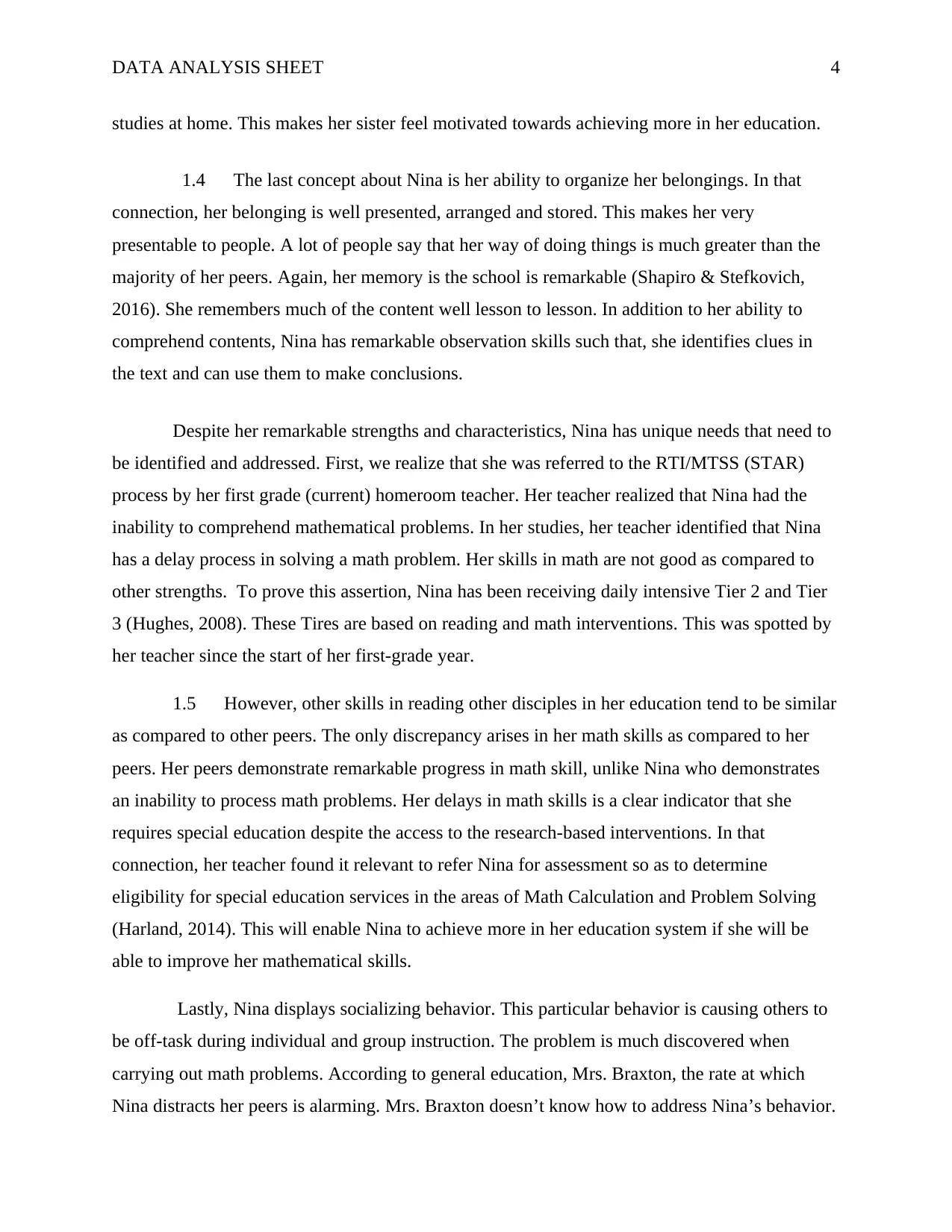
DATA ANALYSIS SHEET 4
studies at home. This makes her sister feel motivated towards achieving more in her education.
1.4 The last concept about Nina is her ability to organize her belongings. In that
connection, her belonging is well presented, arranged and stored. This makes her very
presentable to people. A lot of people say that her way of doing things is much greater than the
majority of her peers. Again, her memory is the school is remarkable (Shapiro & Stefkovich,
2016). She remembers much of the content well lesson to lesson. In addition to her ability to
comprehend contents, Nina has remarkable observation skills such that, she identifies clues in
the text and can use them to make conclusions.
Despite her remarkable strengths and characteristics, Nina has unique needs that need to
be identified and addressed. First, we realize that she was referred to the RTI/MTSS (STAR)
process by her first grade (current) homeroom teacher. Her teacher realized that Nina had the
inability to comprehend mathematical problems. In her studies, her teacher identified that Nina
has a delay process in solving a math problem. Her skills in math are not good as compared to
other strengths. To prove this assertion, Nina has been receiving daily intensive Tier 2 and Tier
3 (Hughes, 2008). These Tires are based on reading and math interventions. This was spotted by
her teacher since the start of her first-grade year.
1.5 However, other skills in reading other disciples in her education tend to be similar
as compared to other peers. The only discrepancy arises in her math skills as compared to her
peers. Her peers demonstrate remarkable progress in math skill, unlike Nina who demonstrates
an inability to process math problems. Her delays in math skills is a clear indicator that she
requires special education despite the access to the research-based interventions. In that
connection, her teacher found it relevant to refer Nina for assessment so as to determine
eligibility for special education services in the areas of Math Calculation and Problem Solving
(Harland, 2014). This will enable Nina to achieve more in her education system if she will be
able to improve her mathematical skills.
Lastly, Nina displays socializing behavior. This particular behavior is causing others to
be off-task during individual and group instruction. The problem is much discovered when
carrying out math problems. According to general education, Mrs. Braxton, the rate at which
Nina distracts her peers is alarming. Mrs. Braxton doesn’t know how to address Nina’s behavior.
studies at home. This makes her sister feel motivated towards achieving more in her education.
1.4 The last concept about Nina is her ability to organize her belongings. In that
connection, her belonging is well presented, arranged and stored. This makes her very
presentable to people. A lot of people say that her way of doing things is much greater than the
majority of her peers. Again, her memory is the school is remarkable (Shapiro & Stefkovich,
2016). She remembers much of the content well lesson to lesson. In addition to her ability to
comprehend contents, Nina has remarkable observation skills such that, she identifies clues in
the text and can use them to make conclusions.
Despite her remarkable strengths and characteristics, Nina has unique needs that need to
be identified and addressed. First, we realize that she was referred to the RTI/MTSS (STAR)
process by her first grade (current) homeroom teacher. Her teacher realized that Nina had the
inability to comprehend mathematical problems. In her studies, her teacher identified that Nina
has a delay process in solving a math problem. Her skills in math are not good as compared to
other strengths. To prove this assertion, Nina has been receiving daily intensive Tier 2 and Tier
3 (Hughes, 2008). These Tires are based on reading and math interventions. This was spotted by
her teacher since the start of her first-grade year.
1.5 However, other skills in reading other disciples in her education tend to be similar
as compared to other peers. The only discrepancy arises in her math skills as compared to her
peers. Her peers demonstrate remarkable progress in math skill, unlike Nina who demonstrates
an inability to process math problems. Her delays in math skills is a clear indicator that she
requires special education despite the access to the research-based interventions. In that
connection, her teacher found it relevant to refer Nina for assessment so as to determine
eligibility for special education services in the areas of Math Calculation and Problem Solving
(Harland, 2014). This will enable Nina to achieve more in her education system if she will be
able to improve her mathematical skills.
Lastly, Nina displays socializing behavior. This particular behavior is causing others to
be off-task during individual and group instruction. The problem is much discovered when
carrying out math problems. According to general education, Mrs. Braxton, the rate at which
Nina distracts her peers is alarming. Mrs. Braxton doesn’t know how to address Nina’s behavior.
Secure Best Marks with AI Grader
Need help grading? Try our AI Grader for instant feedback on your assignments.

DATA ANALYSIS SHEET 5
She finds it difficult to have Nina in a class of normal children. According to her assessment,
Mrs. Braxton finds it better to relocate Nina to a special education facility for close observation
and instruction.
2.0 Data Source
2.1 Data regarding Nina’s behavior was collected from several individuals through the
interview. Come of individuals interviewed regarding Nina’s case include her mother, her father,
Mrs. Braxton and her current teacher.
Interview with Jess, Nina’s Mother on 21st January 2018. According to Nina’s mother,
the report indicates that Nina is a unique child with a certain strength that cannot be compared
with her peers. Jess says in the interview that Nina is an attractive child who performs certain
activities with ease. Some of the activities that Nina enjoy most include playing piano from her
father’s music room. Jess said that Nina started expressing interests in music when she was 2
years old. She used to enjoy the sound produced by the piano. At her current age, Nina has the
ability to play music using the piano instrument. This is a skill that many people including adult
have not managed to achieve in their lifetime (Gioia, Corley & Hamilton, 2013). Thus Jess
realized that Nina has a talent despite her low skills in solving mathematical problems. Jess says
that the education system should offer equal chances to children with other talents even if their
mathematical skills are in question. There should be diversification in the education system.
However, Nina’s mother was not comfortable with some behaviors portrayed by Nina at school.
Nina has been disrupting her peers at school during individual work and group work. Grabbing
the attention of other children during learning sessions should be addressed by teachers to avoid
low performance in school.
Interview with Nina’s current teacher held on 22nd January 2018. This interview was
held to determine how Nina has respondent to special education services being offered by her
current teacher. The report indicates that there has been a remarkable improvement on how Nina
is responding to a mathematical problem that the teacher is assessing Nina. However, the teacher
said that more and repeated study mathematical tests should be subjected to Nina until she grasps
the content fully. She finally understands the content being taught. Then major concert is time
taken by Nina to understand the content. She takes a lot of time to comprehend the mathematical
She finds it difficult to have Nina in a class of normal children. According to her assessment,
Mrs. Braxton finds it better to relocate Nina to a special education facility for close observation
and instruction.
2.0 Data Source
2.1 Data regarding Nina’s behavior was collected from several individuals through the
interview. Come of individuals interviewed regarding Nina’s case include her mother, her father,
Mrs. Braxton and her current teacher.
Interview with Jess, Nina’s Mother on 21st January 2018. According to Nina’s mother,
the report indicates that Nina is a unique child with a certain strength that cannot be compared
with her peers. Jess says in the interview that Nina is an attractive child who performs certain
activities with ease. Some of the activities that Nina enjoy most include playing piano from her
father’s music room. Jess said that Nina started expressing interests in music when she was 2
years old. She used to enjoy the sound produced by the piano. At her current age, Nina has the
ability to play music using the piano instrument. This is a skill that many people including adult
have not managed to achieve in their lifetime (Gioia, Corley & Hamilton, 2013). Thus Jess
realized that Nina has a talent despite her low skills in solving mathematical problems. Jess says
that the education system should offer equal chances to children with other talents even if their
mathematical skills are in question. There should be diversification in the education system.
However, Nina’s mother was not comfortable with some behaviors portrayed by Nina at school.
Nina has been disrupting her peers at school during individual work and group work. Grabbing
the attention of other children during learning sessions should be addressed by teachers to avoid
low performance in school.
Interview with Nina’s current teacher held on 22nd January 2018. This interview was
held to determine how Nina has respondent to special education services being offered by her
current teacher. The report indicates that there has been a remarkable improvement on how Nina
is responding to a mathematical problem that the teacher is assessing Nina. However, the teacher
said that more and repeated study mathematical tests should be subjected to Nina until she grasps
the content fully. She finally understands the content being taught. Then major concert is time
taken by Nina to understand the content. She takes a lot of time to comprehend the mathematical
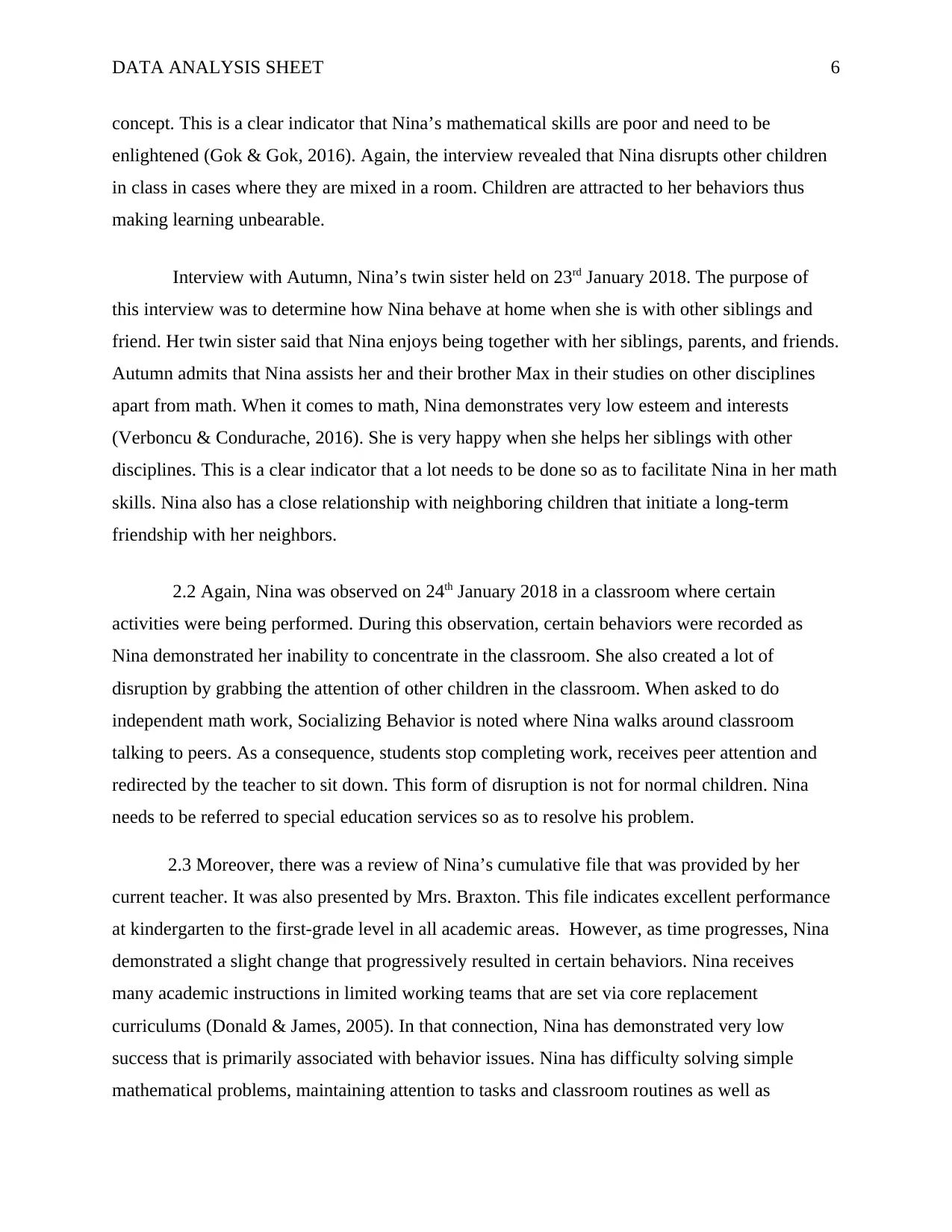
DATA ANALYSIS SHEET 6
concept. This is a clear indicator that Nina’s mathematical skills are poor and need to be
enlightened (Gok & Gok, 2016). Again, the interview revealed that Nina disrupts other children
in class in cases where they are mixed in a room. Children are attracted to her behaviors thus
making learning unbearable.
Interview with Autumn, Nina’s twin sister held on 23rd January 2018. The purpose of
this interview was to determine how Nina behave at home when she is with other siblings and
friend. Her twin sister said that Nina enjoys being together with her siblings, parents, and friends.
Autumn admits that Nina assists her and their brother Max in their studies on other disciplines
apart from math. When it comes to math, Nina demonstrates very low esteem and interests
(Verboncu & Condurache, 2016). She is very happy when she helps her siblings with other
disciplines. This is a clear indicator that a lot needs to be done so as to facilitate Nina in her math
skills. Nina also has a close relationship with neighboring children that initiate a long-term
friendship with her neighbors.
2.2 Again, Nina was observed on 24th January 2018 in a classroom where certain
activities were being performed. During this observation, certain behaviors were recorded as
Nina demonstrated her inability to concentrate in the classroom. She also created a lot of
disruption by grabbing the attention of other children in the classroom. When asked to do
independent math work, Socializing Behavior is noted where Nina walks around classroom
talking to peers. As a consequence, students stop completing work, receives peer attention and
redirected by the teacher to sit down. This form of disruption is not for normal children. Nina
needs to be referred to special education services so as to resolve his problem.
2.3 Moreover, there was a review of Nina’s cumulative file that was provided by her
current teacher. It was also presented by Mrs. Braxton. This file indicates excellent performance
at kindergarten to the first-grade level in all academic areas. However, as time progresses, Nina
demonstrated a slight change that progressively resulted in certain behaviors. Nina receives
many academic instructions in limited working teams that are set via core replacement
curriculums (Donald & James, 2005). In that connection, Nina has demonstrated very low
success that is primarily associated with behavior issues. Nina has difficulty solving simple
mathematical problems, maintaining attention to tasks and classroom routines as well as
concept. This is a clear indicator that Nina’s mathematical skills are poor and need to be
enlightened (Gok & Gok, 2016). Again, the interview revealed that Nina disrupts other children
in class in cases where they are mixed in a room. Children are attracted to her behaviors thus
making learning unbearable.
Interview with Autumn, Nina’s twin sister held on 23rd January 2018. The purpose of
this interview was to determine how Nina behave at home when she is with other siblings and
friend. Her twin sister said that Nina enjoys being together with her siblings, parents, and friends.
Autumn admits that Nina assists her and their brother Max in their studies on other disciplines
apart from math. When it comes to math, Nina demonstrates very low esteem and interests
(Verboncu & Condurache, 2016). She is very happy when she helps her siblings with other
disciplines. This is a clear indicator that a lot needs to be done so as to facilitate Nina in her math
skills. Nina also has a close relationship with neighboring children that initiate a long-term
friendship with her neighbors.
2.2 Again, Nina was observed on 24th January 2018 in a classroom where certain
activities were being performed. During this observation, certain behaviors were recorded as
Nina demonstrated her inability to concentrate in the classroom. She also created a lot of
disruption by grabbing the attention of other children in the classroom. When asked to do
independent math work, Socializing Behavior is noted where Nina walks around classroom
talking to peers. As a consequence, students stop completing work, receives peer attention and
redirected by the teacher to sit down. This form of disruption is not for normal children. Nina
needs to be referred to special education services so as to resolve his problem.
2.3 Moreover, there was a review of Nina’s cumulative file that was provided by her
current teacher. It was also presented by Mrs. Braxton. This file indicates excellent performance
at kindergarten to the first-grade level in all academic areas. However, as time progresses, Nina
demonstrated a slight change that progressively resulted in certain behaviors. Nina receives
many academic instructions in limited working teams that are set via core replacement
curriculums (Donald & James, 2005). In that connection, Nina has demonstrated very low
success that is primarily associated with behavior issues. Nina has difficulty solving simple
mathematical problems, maintaining attention to tasks and classroom routines as well as
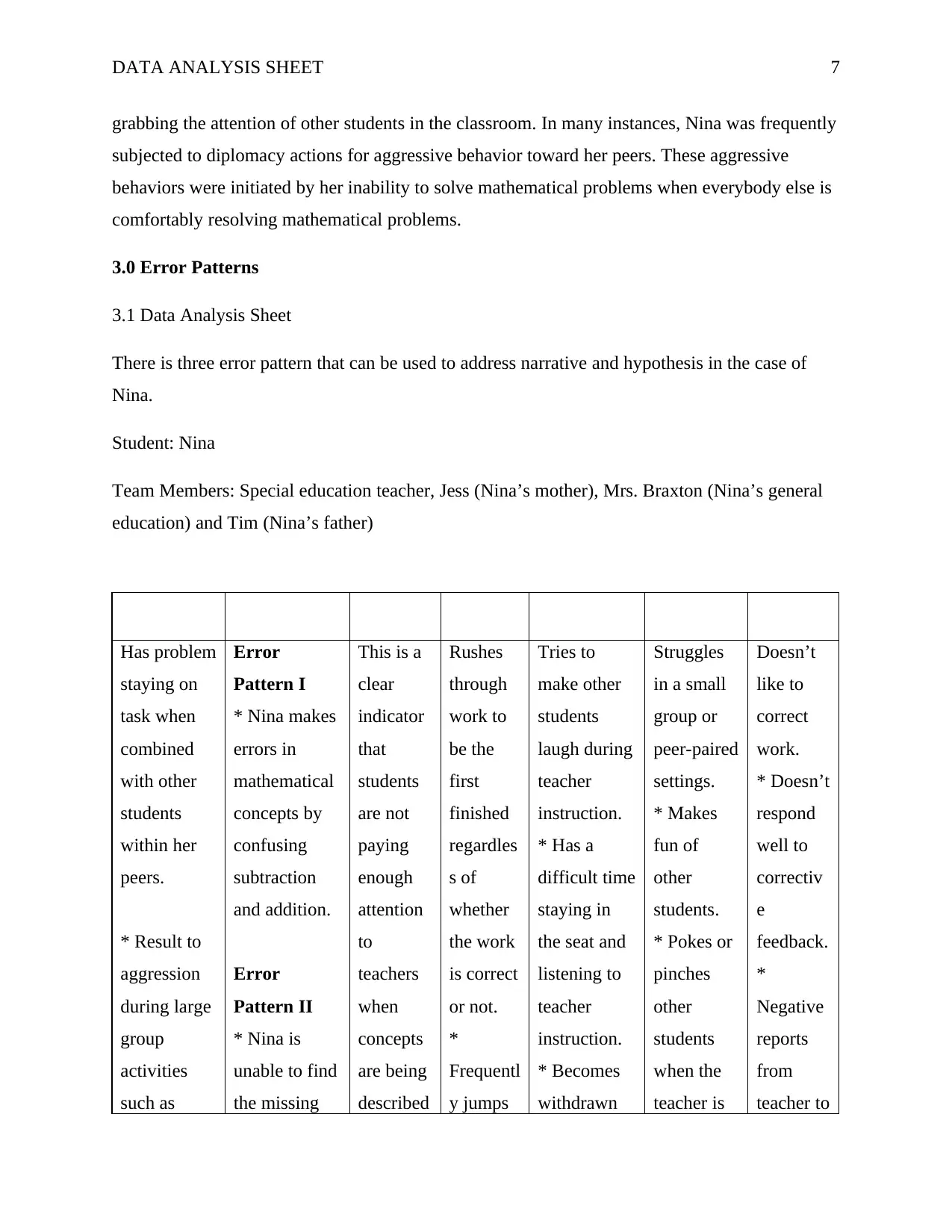
DATA ANALYSIS SHEET 7
grabbing the attention of other students in the classroom. In many instances, Nina was frequently
subjected to diplomacy actions for aggressive behavior toward her peers. These aggressive
behaviors were initiated by her inability to solve mathematical problems when everybody else is
comfortably resolving mathematical problems.
3.0 Error Patterns
3.1 Data Analysis Sheet
There is three error pattern that can be used to address narrative and hypothesis in the case of
Nina.
Student: Nina
Team Members: Special education teacher, Jess (Nina’s mother), Mrs. Braxton (Nina’s general
education) and Tim (Nina’s father)
Has problem
staying on
task when
combined
with other
students
within her
peers.
* Result to
aggression
during large
group
activities
such as
Error
Pattern I
* Nina makes
errors in
mathematical
concepts by
confusing
subtraction
and addition.
Error
Pattern II
* Nina is
unable to find
the missing
This is a
clear
indicator
that
students
are not
paying
enough
attention
to
teachers
when
concepts
are being
described
Rushes
through
work to
be the
first
finished
regardles
s of
whether
the work
is correct
or not.
*
Frequentl
y jumps
Tries to
make other
students
laugh during
teacher
instruction.
* Has a
difficult time
staying in
the seat and
listening to
teacher
instruction.
* Becomes
withdrawn
Struggles
in a small
group or
peer-paired
settings.
* Makes
fun of
other
students.
* Pokes or
pinches
other
students
when the
teacher is
Doesn’t
like to
correct
work.
* Doesn’t
respond
well to
correctiv
e
feedback.
*
Negative
reports
from
teacher to
grabbing the attention of other students in the classroom. In many instances, Nina was frequently
subjected to diplomacy actions for aggressive behavior toward her peers. These aggressive
behaviors were initiated by her inability to solve mathematical problems when everybody else is
comfortably resolving mathematical problems.
3.0 Error Patterns
3.1 Data Analysis Sheet
There is three error pattern that can be used to address narrative and hypothesis in the case of
Nina.
Student: Nina
Team Members: Special education teacher, Jess (Nina’s mother), Mrs. Braxton (Nina’s general
education) and Tim (Nina’s father)
Has problem
staying on
task when
combined
with other
students
within her
peers.
* Result to
aggression
during large
group
activities
such as
Error
Pattern I
* Nina makes
errors in
mathematical
concepts by
confusing
subtraction
and addition.
Error
Pattern II
* Nina is
unable to find
the missing
This is a
clear
indicator
that
students
are not
paying
enough
attention
to
teachers
when
concepts
are being
described
Rushes
through
work to
be the
first
finished
regardles
s of
whether
the work
is correct
or not.
*
Frequentl
y jumps
Tries to
make other
students
laugh during
teacher
instruction.
* Has a
difficult time
staying in
the seat and
listening to
teacher
instruction.
* Becomes
withdrawn
Struggles
in a small
group or
peer-paired
settings.
* Makes
fun of
other
students.
* Pokes or
pinches
other
students
when the
teacher is
Doesn’t
like to
correct
work.
* Doesn’t
respond
well to
correctiv
e
feedback.
*
Negative
reports
from
teacher to
Paraphrase This Document
Need a fresh take? Get an instant paraphrase of this document with our AI Paraphraser
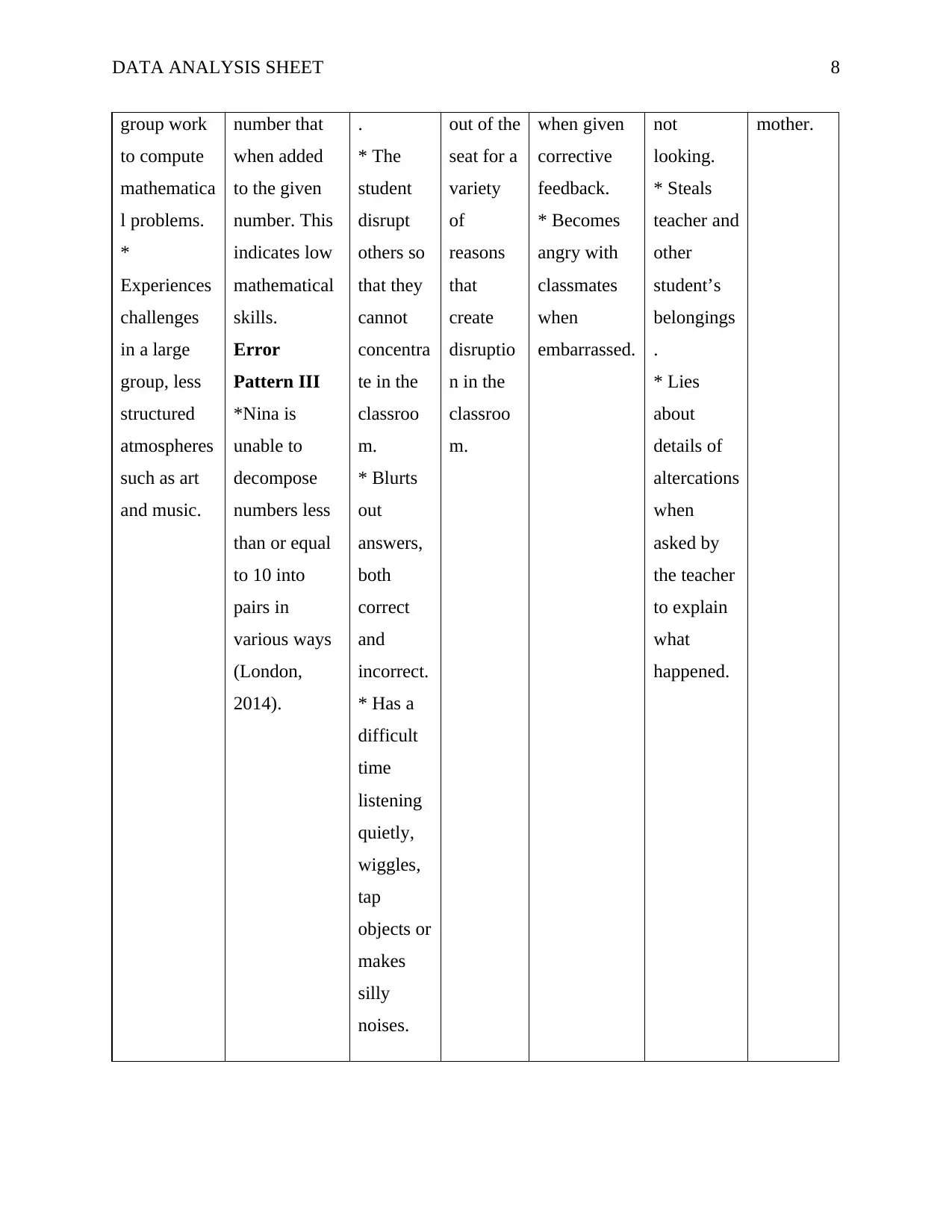
DATA ANALYSIS SHEET 8
group work
to compute
mathematica
l problems.
*
Experiences
challenges
in a large
group, less
structured
atmospheres
such as art
and music.
number that
when added
to the given
number. This
indicates low
mathematical
skills.
Error
Pattern III
*Nina is
unable to
decompose
numbers less
than or equal
to 10 into
pairs in
various ways
(London,
2014).
.
* The
student
disrupt
others so
that they
cannot
concentra
te in the
classroo
m.
* Blurts
out
answers,
both
correct
and
incorrect.
* Has a
difficult
time
listening
quietly,
wiggles,
tap
objects or
makes
silly
noises.
out of the
seat for a
variety
of
reasons
that
create
disruptio
n in the
classroo
m.
when given
corrective
feedback.
* Becomes
angry with
classmates
when
embarrassed.
not
looking.
* Steals
teacher and
other
student’s
belongings
.
* Lies
about
details of
altercations
when
asked by
the teacher
to explain
what
happened.
mother.
group work
to compute
mathematica
l problems.
*
Experiences
challenges
in a large
group, less
structured
atmospheres
such as art
and music.
number that
when added
to the given
number. This
indicates low
mathematical
skills.
Error
Pattern III
*Nina is
unable to
decompose
numbers less
than or equal
to 10 into
pairs in
various ways
(London,
2014).
.
* The
student
disrupt
others so
that they
cannot
concentra
te in the
classroo
m.
* Blurts
out
answers,
both
correct
and
incorrect.
* Has a
difficult
time
listening
quietly,
wiggles,
tap
objects or
makes
silly
noises.
out of the
seat for a
variety
of
reasons
that
create
disruptio
n in the
classroo
m.
when given
corrective
feedback.
* Becomes
angry with
classmates
when
embarrassed.
not
looking.
* Steals
teacher and
other
student’s
belongings
.
* Lies
about
details of
altercations
when
asked by
the teacher
to explain
what
happened.
mother.
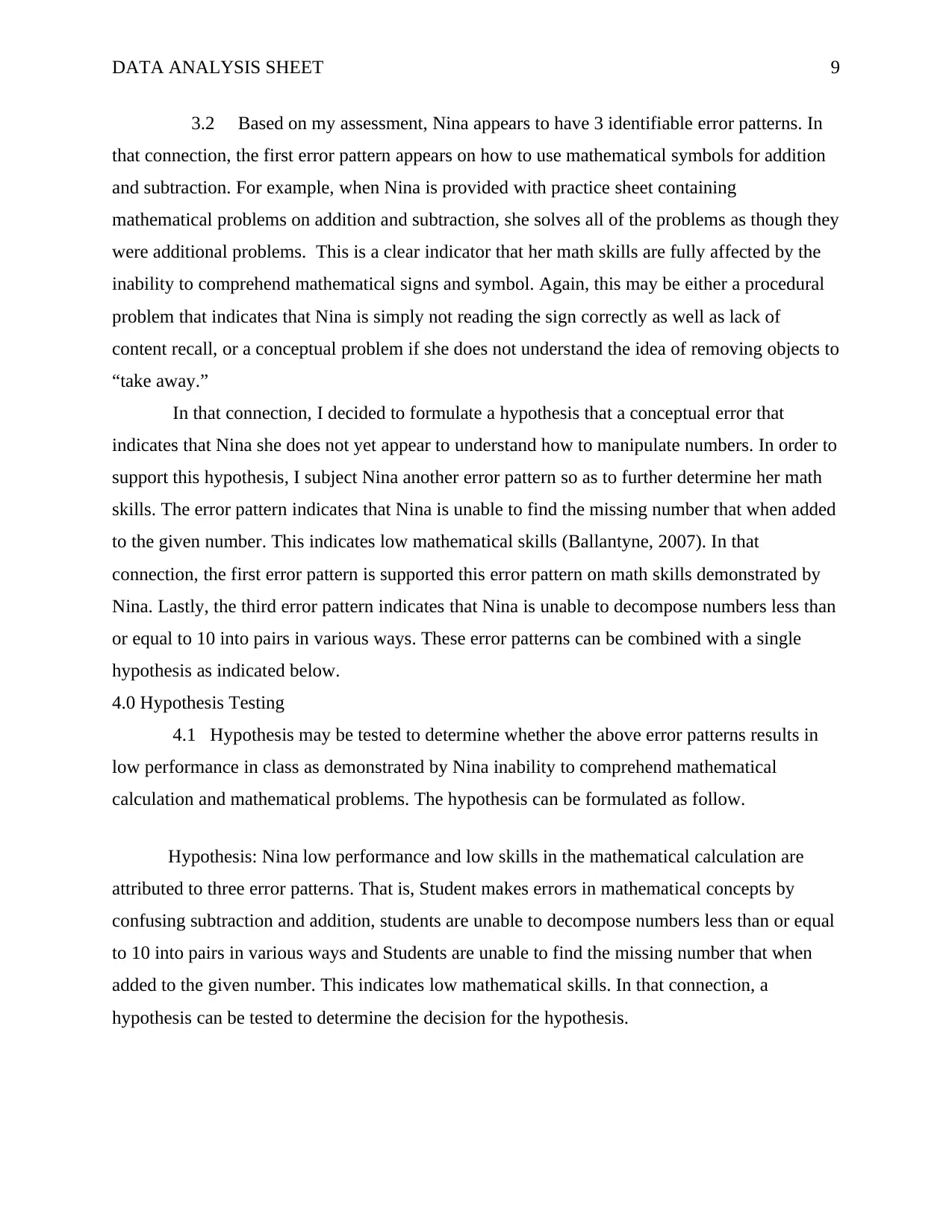
DATA ANALYSIS SHEET 9
3.2 Based on my assessment, Nina appears to have 3 identifiable error patterns. In
that connection, the first error pattern appears on how to use mathematical symbols for addition
and subtraction. For example, when Nina is provided with practice sheet containing
mathematical problems on addition and subtraction, she solves all of the problems as though they
were additional problems. This is a clear indicator that her math skills are fully affected by the
inability to comprehend mathematical signs and symbol. Again, this may be either a procedural
problem that indicates that Nina is simply not reading the sign correctly as well as lack of
content recall, or a conceptual problem if she does not understand the idea of removing objects to
“take away.”
In that connection, I decided to formulate a hypothesis that a conceptual error that
indicates that Nina she does not yet appear to understand how to manipulate numbers. In order to
support this hypothesis, I subject Nina another error pattern so as to further determine her math
skills. The error pattern indicates that Nina is unable to find the missing number that when added
to the given number. This indicates low mathematical skills (Ballantyne, 2007). In that
connection, the first error pattern is supported this error pattern on math skills demonstrated by
Nina. Lastly, the third error pattern indicates that Nina is unable to decompose numbers less than
or equal to 10 into pairs in various ways. These error patterns can be combined with a single
hypothesis as indicated below.
4.0 Hypothesis Testing
4.1 Hypothesis may be tested to determine whether the above error patterns results in
low performance in class as demonstrated by Nina inability to comprehend mathematical
calculation and mathematical problems. The hypothesis can be formulated as follow.
Hypothesis: Nina low performance and low skills in the mathematical calculation are
attributed to three error patterns. That is, Student makes errors in mathematical concepts by
confusing subtraction and addition, students are unable to decompose numbers less than or equal
to 10 into pairs in various ways and Students are unable to find the missing number that when
added to the given number. This indicates low mathematical skills. In that connection, a
hypothesis can be tested to determine the decision for the hypothesis.
3.2 Based on my assessment, Nina appears to have 3 identifiable error patterns. In
that connection, the first error pattern appears on how to use mathematical symbols for addition
and subtraction. For example, when Nina is provided with practice sheet containing
mathematical problems on addition and subtraction, she solves all of the problems as though they
were additional problems. This is a clear indicator that her math skills are fully affected by the
inability to comprehend mathematical signs and symbol. Again, this may be either a procedural
problem that indicates that Nina is simply not reading the sign correctly as well as lack of
content recall, or a conceptual problem if she does not understand the idea of removing objects to
“take away.”
In that connection, I decided to formulate a hypothesis that a conceptual error that
indicates that Nina she does not yet appear to understand how to manipulate numbers. In order to
support this hypothesis, I subject Nina another error pattern so as to further determine her math
skills. The error pattern indicates that Nina is unable to find the missing number that when added
to the given number. This indicates low mathematical skills (Ballantyne, 2007). In that
connection, the first error pattern is supported this error pattern on math skills demonstrated by
Nina. Lastly, the third error pattern indicates that Nina is unable to decompose numbers less than
or equal to 10 into pairs in various ways. These error patterns can be combined with a single
hypothesis as indicated below.
4.0 Hypothesis Testing
4.1 Hypothesis may be tested to determine whether the above error patterns results in
low performance in class as demonstrated by Nina inability to comprehend mathematical
calculation and mathematical problems. The hypothesis can be formulated as follow.
Hypothesis: Nina low performance and low skills in the mathematical calculation are
attributed to three error patterns. That is, Student makes errors in mathematical concepts by
confusing subtraction and addition, students are unable to decompose numbers less than or equal
to 10 into pairs in various ways and Students are unable to find the missing number that when
added to the given number. This indicates low mathematical skills. In that connection, a
hypothesis can be tested to determine the decision for the hypothesis.
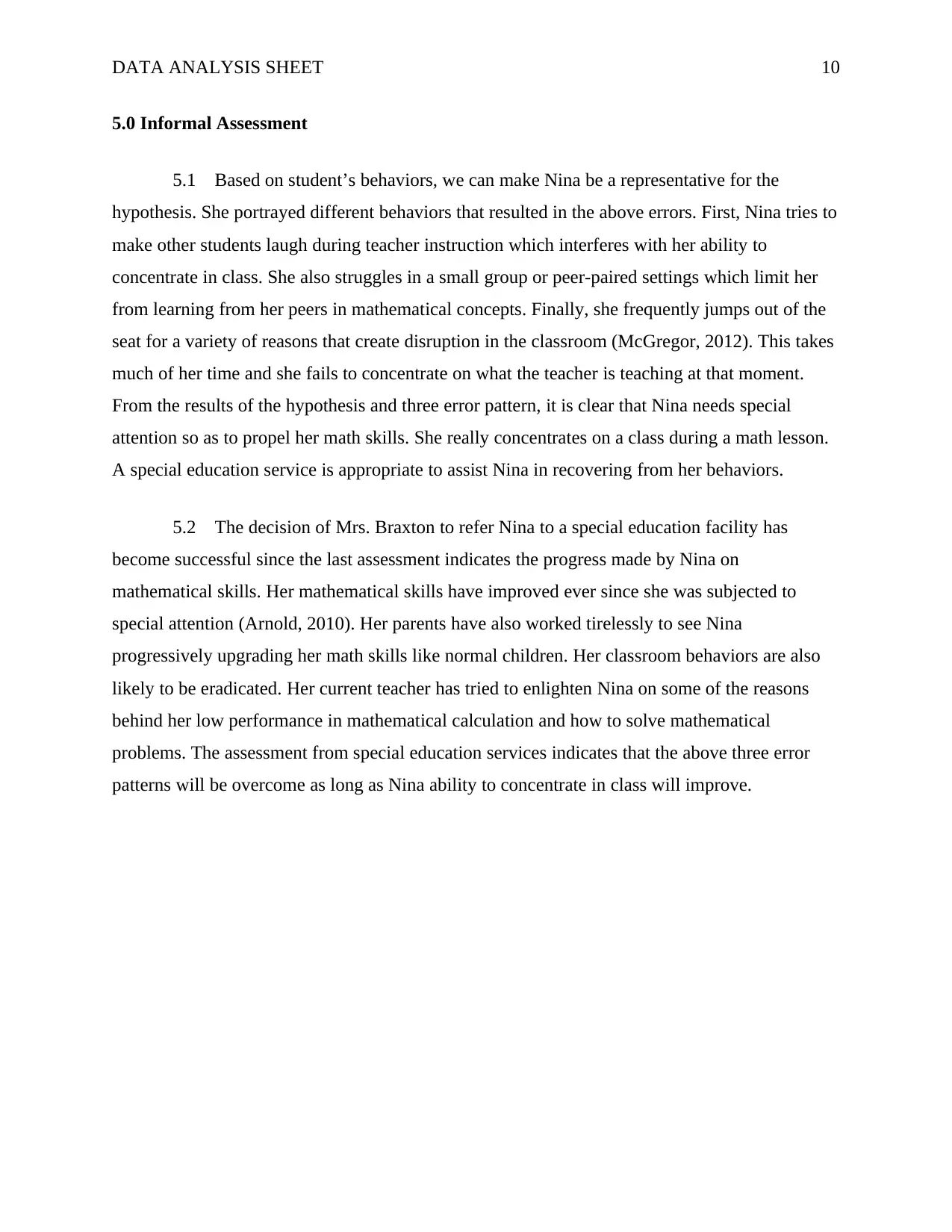
DATA ANALYSIS SHEET 10
5.0 Informal Assessment
5.1 Based on student’s behaviors, we can make Nina be a representative for the
hypothesis. She portrayed different behaviors that resulted in the above errors. First, Nina tries to
make other students laugh during teacher instruction which interferes with her ability to
concentrate in class. She also struggles in a small group or peer-paired settings which limit her
from learning from her peers in mathematical concepts. Finally, she frequently jumps out of the
seat for a variety of reasons that create disruption in the classroom (McGregor, 2012). This takes
much of her time and she fails to concentrate on what the teacher is teaching at that moment.
From the results of the hypothesis and three error pattern, it is clear that Nina needs special
attention so as to propel her math skills. She really concentrates on a class during a math lesson.
A special education service is appropriate to assist Nina in recovering from her behaviors.
5.2 The decision of Mrs. Braxton to refer Nina to a special education facility has
become successful since the last assessment indicates the progress made by Nina on
mathematical skills. Her mathematical skills have improved ever since she was subjected to
special attention (Arnold, 2010). Her parents have also worked tirelessly to see Nina
progressively upgrading her math skills like normal children. Her classroom behaviors are also
likely to be eradicated. Her current teacher has tried to enlighten Nina on some of the reasons
behind her low performance in mathematical calculation and how to solve mathematical
problems. The assessment from special education services indicates that the above three error
patterns will be overcome as long as Nina ability to concentrate in class will improve.
5.0 Informal Assessment
5.1 Based on student’s behaviors, we can make Nina be a representative for the
hypothesis. She portrayed different behaviors that resulted in the above errors. First, Nina tries to
make other students laugh during teacher instruction which interferes with her ability to
concentrate in class. She also struggles in a small group or peer-paired settings which limit her
from learning from her peers in mathematical concepts. Finally, she frequently jumps out of the
seat for a variety of reasons that create disruption in the classroom (McGregor, 2012). This takes
much of her time and she fails to concentrate on what the teacher is teaching at that moment.
From the results of the hypothesis and three error pattern, it is clear that Nina needs special
attention so as to propel her math skills. She really concentrates on a class during a math lesson.
A special education service is appropriate to assist Nina in recovering from her behaviors.
5.2 The decision of Mrs. Braxton to refer Nina to a special education facility has
become successful since the last assessment indicates the progress made by Nina on
mathematical skills. Her mathematical skills have improved ever since she was subjected to
special attention (Arnold, 2010). Her parents have also worked tirelessly to see Nina
progressively upgrading her math skills like normal children. Her classroom behaviors are also
likely to be eradicated. Her current teacher has tried to enlighten Nina on some of the reasons
behind her low performance in mathematical calculation and how to solve mathematical
problems. The assessment from special education services indicates that the above three error
patterns will be overcome as long as Nina ability to concentrate in class will improve.
Secure Best Marks with AI Grader
Need help grading? Try our AI Grader for instant feedback on your assignments.
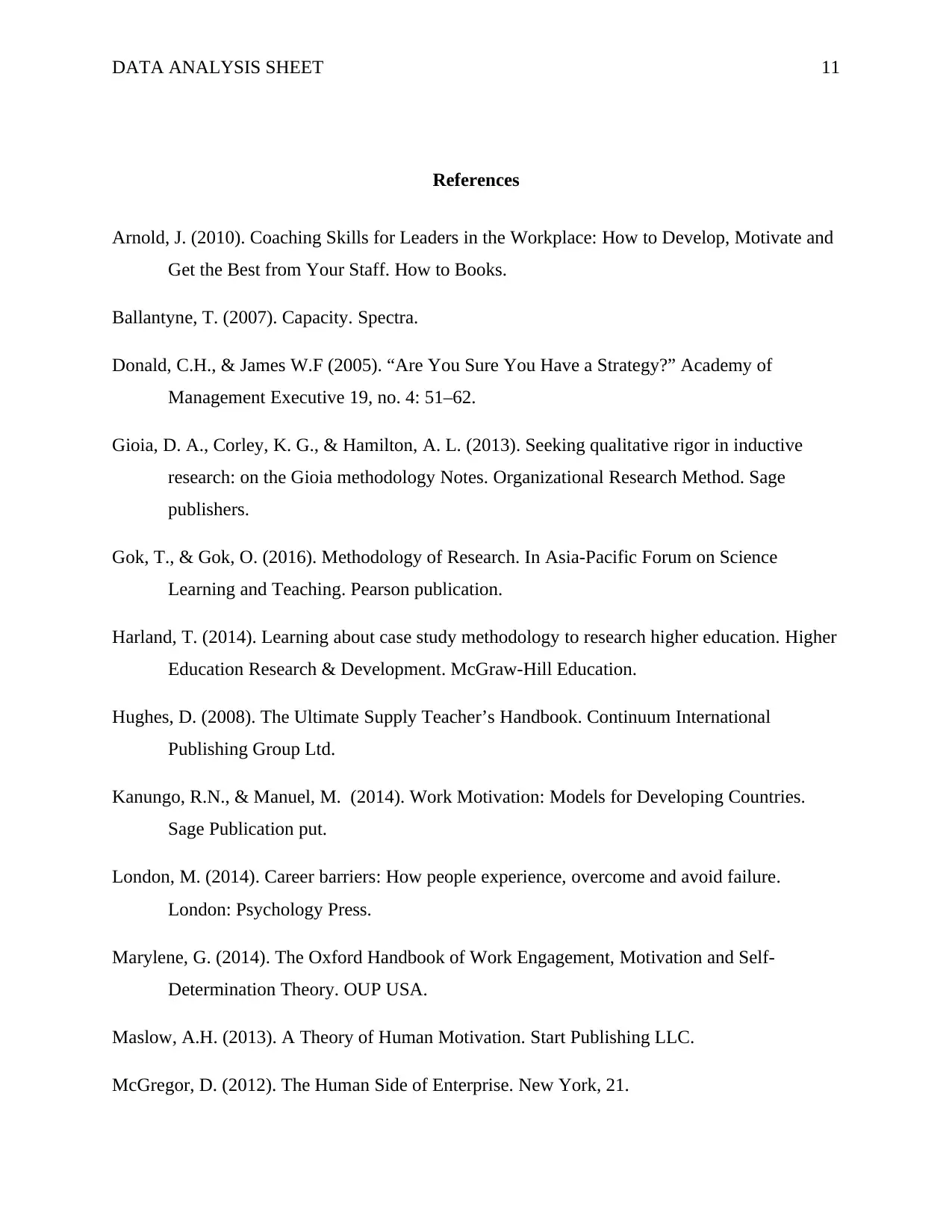
DATA ANALYSIS SHEET 11
References
Arnold, J. (2010). Coaching Skills for Leaders in the Workplace: How to Develop, Motivate and
Get the Best from Your Staff. How to Books.
Ballantyne, T. (2007). Capacity. Spectra.
Donald, C.H., & James W.F (2005). “Are You Sure You Have a Strategy?” Academy of
Management Executive 19, no. 4: 51–62.
Gioia, D. A., Corley, K. G., & Hamilton, A. L. (2013). Seeking qualitative rigor in inductive
research: on the Gioia methodology Notes. Organizational Research Method. Sage
publishers.
Gok, T., & Gok, O. (2016). Methodology of Research. In Asia-Pacific Forum on Science
Learning and Teaching. Pearson publication.
Harland, T. (2014). Learning about case study methodology to research higher education. Higher
Education Research & Development. McGraw-Hill Education.
Hughes, D. (2008). The Ultimate Supply Teacher’s Handbook. Continuum International
Publishing Group Ltd.
Kanungo, R.N., & Manuel, M. (2014). Work Motivation: Models for Developing Countries.
Sage Publication put.
London, M. (2014). Career barriers: How people experience, overcome and avoid failure.
London: Psychology Press.
Marylene, G. (2014). The Oxford Handbook of Work Engagement, Motivation and Self-
Determination Theory. OUP USA.
Maslow, A.H. (2013). A Theory of Human Motivation. Start Publishing LLC.
McGregor, D. (2012). The Human Side of Enterprise. New York, 21.
References
Arnold, J. (2010). Coaching Skills for Leaders in the Workplace: How to Develop, Motivate and
Get the Best from Your Staff. How to Books.
Ballantyne, T. (2007). Capacity. Spectra.
Donald, C.H., & James W.F (2005). “Are You Sure You Have a Strategy?” Academy of
Management Executive 19, no. 4: 51–62.
Gioia, D. A., Corley, K. G., & Hamilton, A. L. (2013). Seeking qualitative rigor in inductive
research: on the Gioia methodology Notes. Organizational Research Method. Sage
publishers.
Gok, T., & Gok, O. (2016). Methodology of Research. In Asia-Pacific Forum on Science
Learning and Teaching. Pearson publication.
Harland, T. (2014). Learning about case study methodology to research higher education. Higher
Education Research & Development. McGraw-Hill Education.
Hughes, D. (2008). The Ultimate Supply Teacher’s Handbook. Continuum International
Publishing Group Ltd.
Kanungo, R.N., & Manuel, M. (2014). Work Motivation: Models for Developing Countries.
Sage Publication put.
London, M. (2014). Career barriers: How people experience, overcome and avoid failure.
London: Psychology Press.
Marylene, G. (2014). The Oxford Handbook of Work Engagement, Motivation and Self-
Determination Theory. OUP USA.
Maslow, A.H. (2013). A Theory of Human Motivation. Start Publishing LLC.
McGregor, D. (2012). The Human Side of Enterprise. New York, 21.
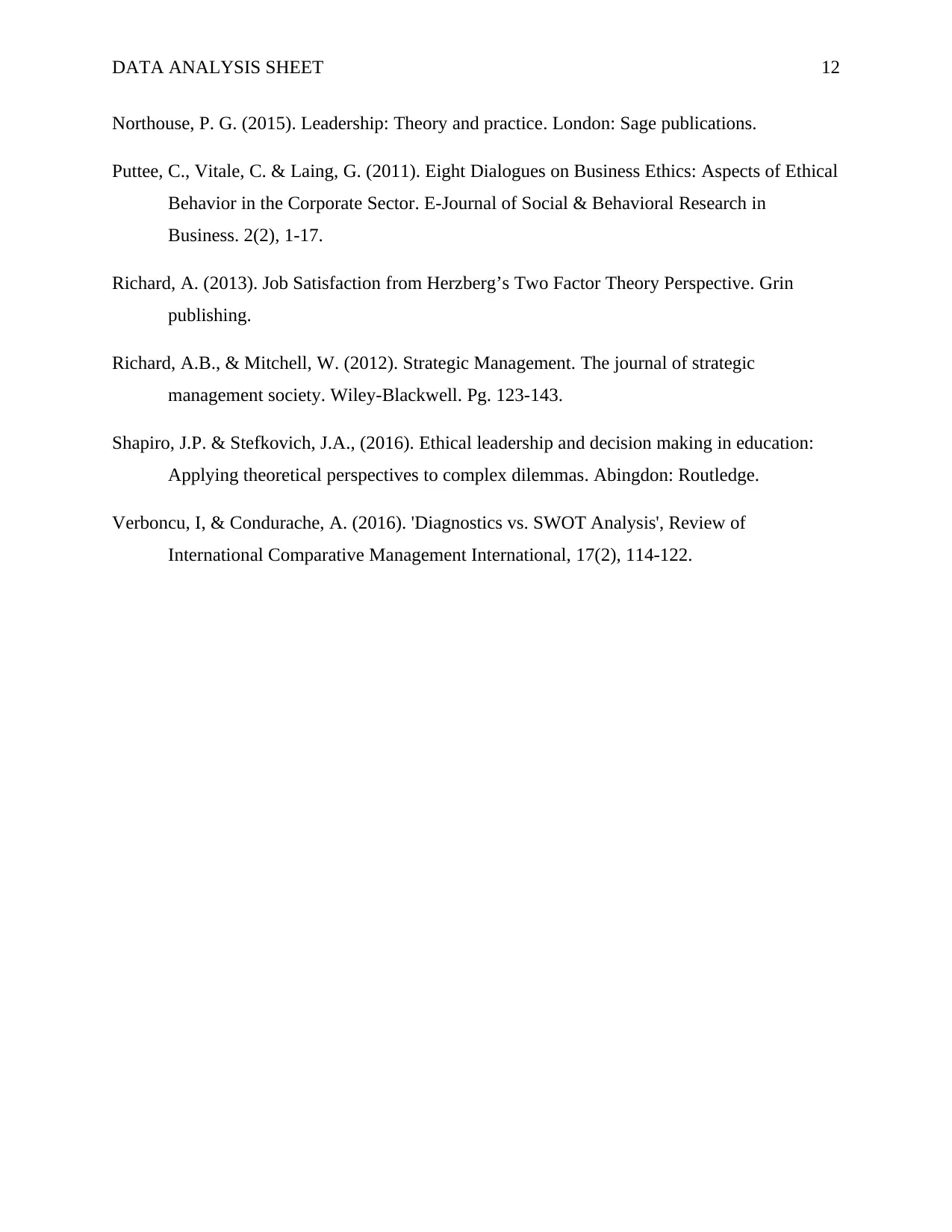
DATA ANALYSIS SHEET 12
Northouse, P. G. (2015). Leadership: Theory and practice. London: Sage publications.
Puttee, C., Vitale, C. & Laing, G. (2011). Eight Dialogues on Business Ethics: Aspects of Ethical
Behavior in the Corporate Sector. E-Journal of Social & Behavioral Research in
Business. 2(2), 1-17.
Richard, A. (2013). Job Satisfaction from Herzberg’s Two Factor Theory Perspective. Grin
publishing.
Richard, A.B., & Mitchell, W. (2012). Strategic Management. The journal of strategic
management society. Wiley-Blackwell. Pg. 123-143.
Shapiro, J.P. & Stefkovich, J.A., (2016). Ethical leadership and decision making in education:
Applying theoretical perspectives to complex dilemmas. Abingdon: Routledge.
Verboncu, I, & Condurache, A. (2016). 'Diagnostics vs. SWOT Analysis', Review of
International Comparative Management International, 17(2), 114-122.
Northouse, P. G. (2015). Leadership: Theory and practice. London: Sage publications.
Puttee, C., Vitale, C. & Laing, G. (2011). Eight Dialogues on Business Ethics: Aspects of Ethical
Behavior in the Corporate Sector. E-Journal of Social & Behavioral Research in
Business. 2(2), 1-17.
Richard, A. (2013). Job Satisfaction from Herzberg’s Two Factor Theory Perspective. Grin
publishing.
Richard, A.B., & Mitchell, W. (2012). Strategic Management. The journal of strategic
management society. Wiley-Blackwell. Pg. 123-143.
Shapiro, J.P. & Stefkovich, J.A., (2016). Ethical leadership and decision making in education:
Applying theoretical perspectives to complex dilemmas. Abingdon: Routledge.
Verboncu, I, & Condurache, A. (2016). 'Diagnostics vs. SWOT Analysis', Review of
International Comparative Management International, 17(2), 114-122.
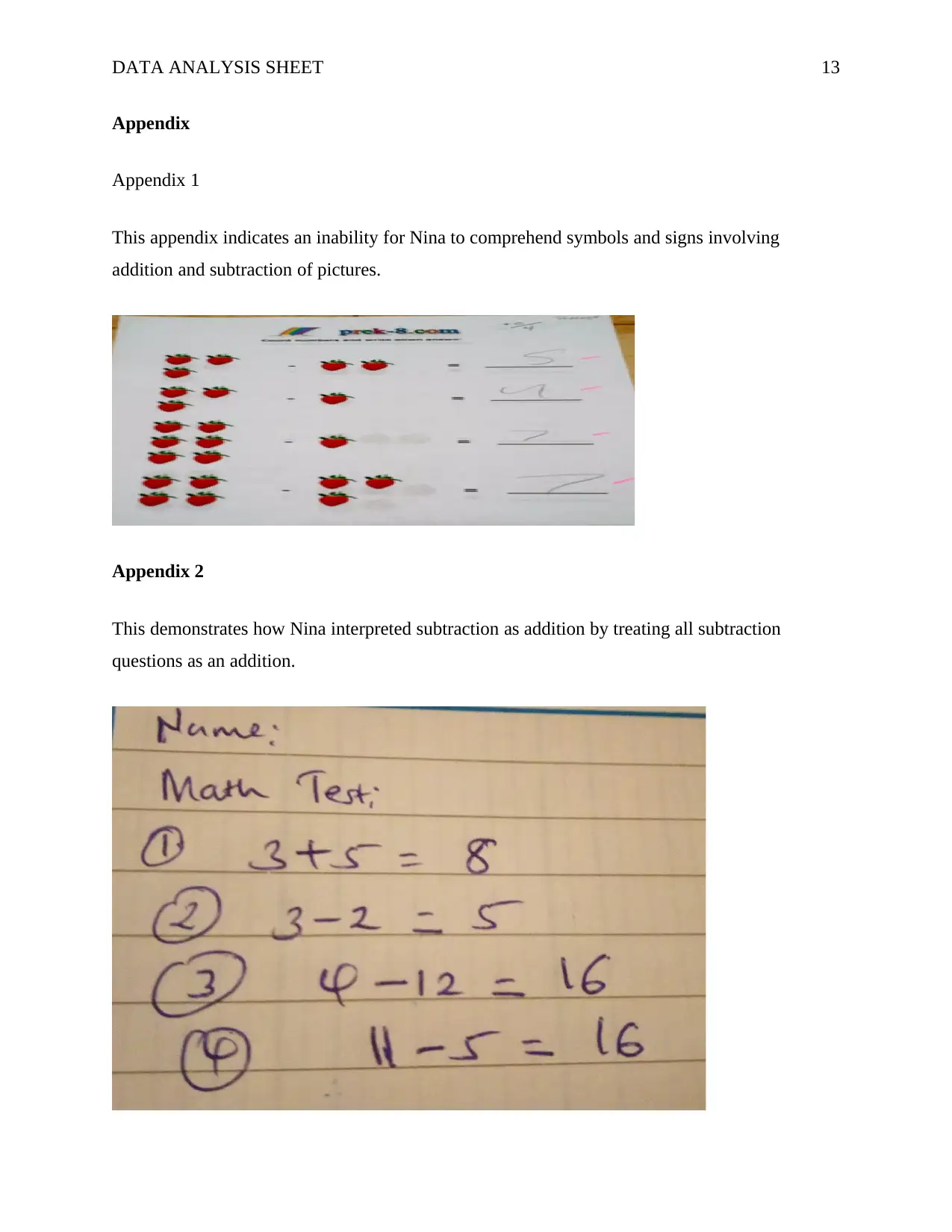
DATA ANALYSIS SHEET 13
Appendix
Appendix 1
This appendix indicates an inability for Nina to comprehend symbols and signs involving
addition and subtraction of pictures.
Appendix 2
This demonstrates how Nina interpreted subtraction as addition by treating all subtraction
questions as an addition.
Appendix
Appendix 1
This appendix indicates an inability for Nina to comprehend symbols and signs involving
addition and subtraction of pictures.
Appendix 2
This demonstrates how Nina interpreted subtraction as addition by treating all subtraction
questions as an addition.
Paraphrase This Document
Need a fresh take? Get an instant paraphrase of this document with our AI Paraphraser
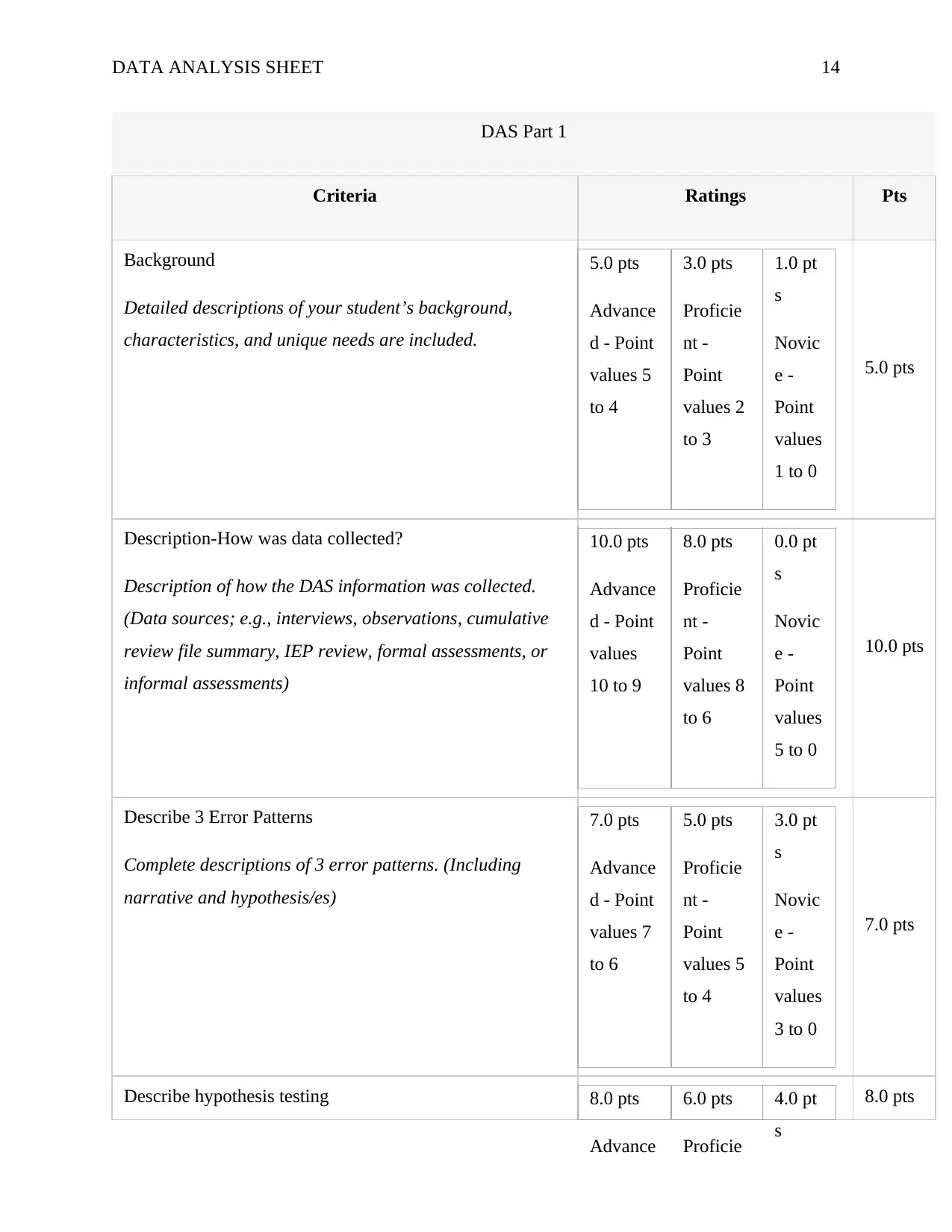
DATA ANALYSIS SHEET 14
DAS Part 1
Criteria Ratings Pts
Background
Detailed descriptions of your student’s background,
characteristics, and unique needs are included.
5.0 pts
Advance
d - Point
values 5
to 4
3.0 pts
Proficie
nt -
Point
values 2
to 3
1.0 pt
s
Novic
e -
Point
values
1 to 0
5.0 pts
Description-How was data collected?
Description of how the DAS information was collected.
(Data sources; e.g., interviews, observations, cumulative
review file summary, IEP review, formal assessments, or
informal assessments)
10.0 pts
Advance
d - Point
values
10 to 9
8.0 pts
Proficie
nt -
Point
values 8
to 6
0.0 pt
s
Novic
e -
Point
values
5 to 0
10.0 pts
Describe 3 Error Patterns
Complete descriptions of 3 error patterns. (Including
narrative and hypothesis/es)
7.0 pts
Advance
d - Point
values 7
to 6
5.0 pts
Proficie
nt -
Point
values 5
to 4
3.0 pt
s
Novic
e -
Point
values
3 to 0
7.0 pts
Describe hypothesis testing 8.0 pts
Advance
6.0 pts
Proficie
4.0 pt
s
8.0 pts
DAS Part 1
Criteria Ratings Pts
Background
Detailed descriptions of your student’s background,
characteristics, and unique needs are included.
5.0 pts
Advance
d - Point
values 5
to 4
3.0 pts
Proficie
nt -
Point
values 2
to 3
1.0 pt
s
Novic
e -
Point
values
1 to 0
5.0 pts
Description-How was data collected?
Description of how the DAS information was collected.
(Data sources; e.g., interviews, observations, cumulative
review file summary, IEP review, formal assessments, or
informal assessments)
10.0 pts
Advance
d - Point
values
10 to 9
8.0 pts
Proficie
nt -
Point
values 8
to 6
0.0 pt
s
Novic
e -
Point
values
5 to 0
10.0 pts
Describe 3 Error Patterns
Complete descriptions of 3 error patterns. (Including
narrative and hypothesis/es)
7.0 pts
Advance
d - Point
values 7
to 6
5.0 pts
Proficie
nt -
Point
values 5
to 4
3.0 pt
s
Novic
e -
Point
values
3 to 0
7.0 pts
Describe hypothesis testing 8.0 pts
Advance
6.0 pts
Proficie
4.0 pt
s
8.0 pts
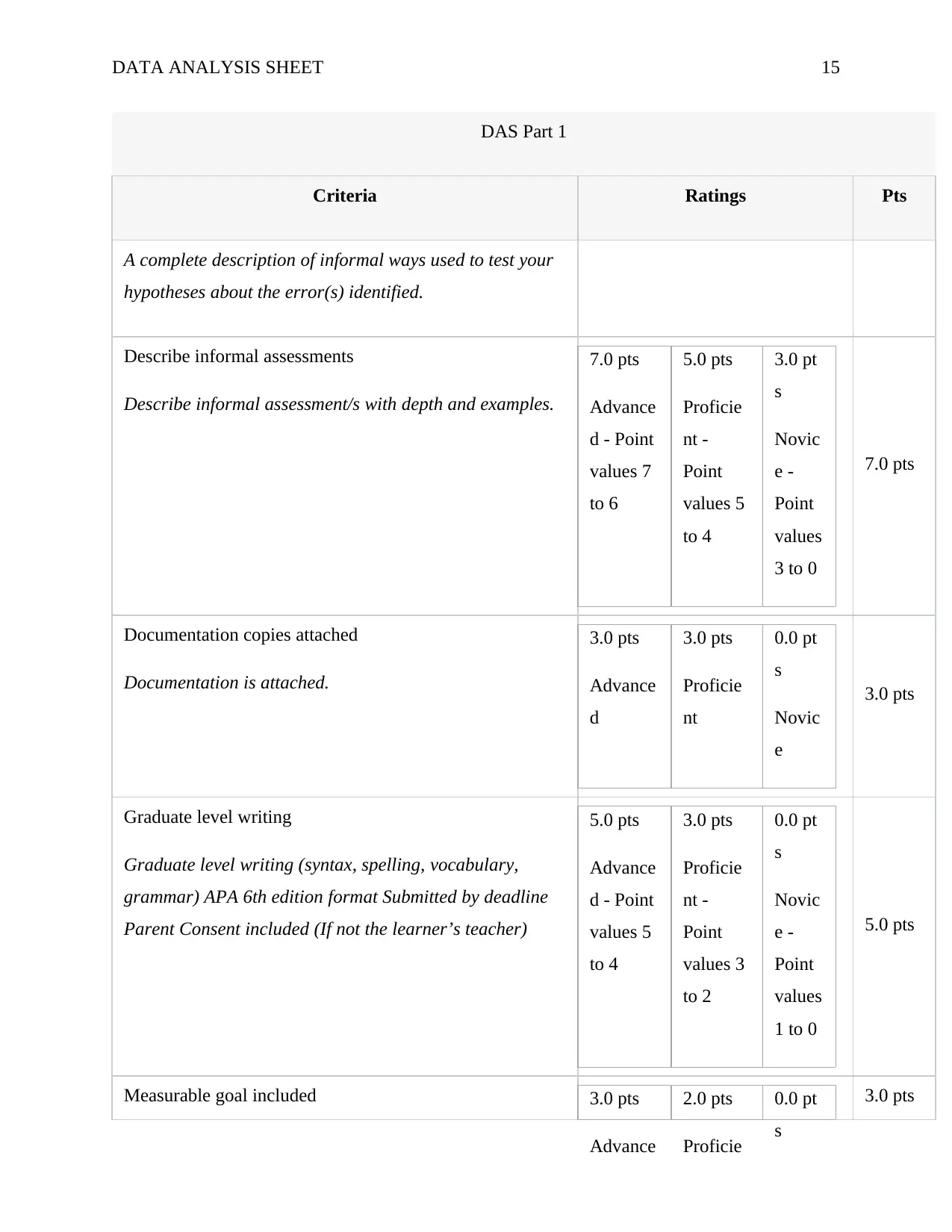
DATA ANALYSIS SHEET 15
DAS Part 1
Criteria Ratings Pts
A complete description of informal ways used to test your
hypotheses about the error(s) identified.
Describe informal assessments
Describe informal assessment/s with depth and examples.
7.0 pts
Advance
d - Point
values 7
to 6
5.0 pts
Proficie
nt -
Point
values 5
to 4
3.0 pt
s
Novic
e -
Point
values
3 to 0
7.0 pts
Documentation copies attached
Documentation is attached.
3.0 pts
Advance
d
3.0 pts
Proficie
nt
0.0 pt
s
Novic
e
3.0 pts
Graduate level writing
Graduate level writing (syntax, spelling, vocabulary,
grammar) APA 6th edition format Submitted by deadline
Parent Consent included (If not the learner’s teacher)
5.0 pts
Advance
d - Point
values 5
to 4
3.0 pts
Proficie
nt -
Point
values 3
to 2
0.0 pt
s
Novic
e -
Point
values
1 to 0
5.0 pts
Measurable goal included 3.0 pts
Advance
2.0 pts
Proficie
0.0 pt
s
3.0 pts
DAS Part 1
Criteria Ratings Pts
A complete description of informal ways used to test your
hypotheses about the error(s) identified.
Describe informal assessments
Describe informal assessment/s with depth and examples.
7.0 pts
Advance
d - Point
values 7
to 6
5.0 pts
Proficie
nt -
Point
values 5
to 4
3.0 pt
s
Novic
e -
Point
values
3 to 0
7.0 pts
Documentation copies attached
Documentation is attached.
3.0 pts
Advance
d
3.0 pts
Proficie
nt
0.0 pt
s
Novic
e
3.0 pts
Graduate level writing
Graduate level writing (syntax, spelling, vocabulary,
grammar) APA 6th edition format Submitted by deadline
Parent Consent included (If not the learner’s teacher)
5.0 pts
Advance
d - Point
values 5
to 4
3.0 pts
Proficie
nt -
Point
values 3
to 2
0.0 pt
s
Novic
e -
Point
values
1 to 0
5.0 pts
Measurable goal included 3.0 pts
Advance
2.0 pts
Proficie
0.0 pt
s
3.0 pts
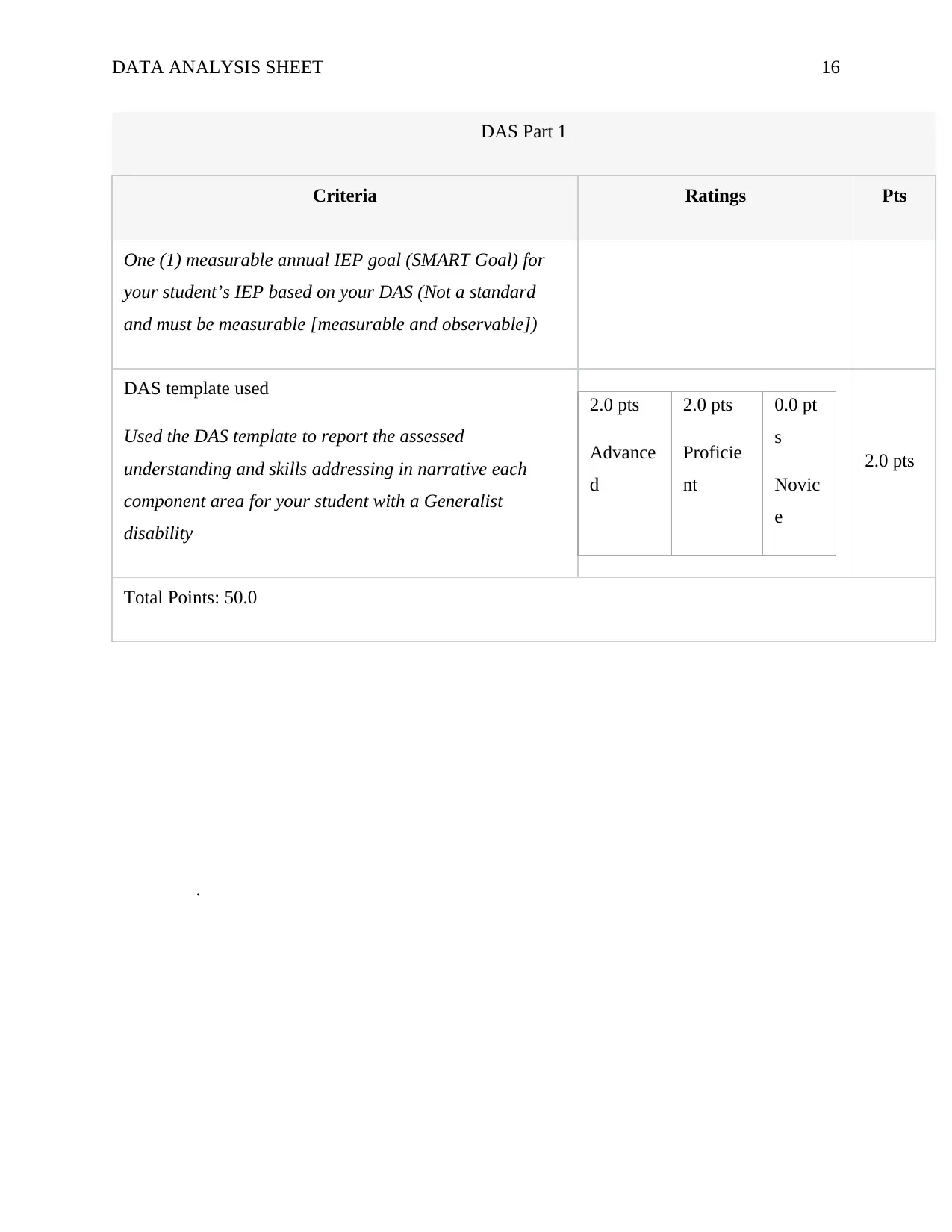
DATA ANALYSIS SHEET 16
DAS Part 1
Criteria Ratings Pts
One (1) measurable annual IEP goal (SMART Goal) for
your student’s IEP based on your DAS (Not a standard
and must be measurable [measurable and observable])
DAS template used
Used the DAS template to report the assessed
understanding and skills addressing in narrative each
component area for your student with a Generalist
disability
2.0 pts
Advance
d
2.0 pts
Proficie
nt
0.0 pt
s
Novic
e
2.0 pts
Total Points: 50.0
.
DAS Part 1
Criteria Ratings Pts
One (1) measurable annual IEP goal (SMART Goal) for
your student’s IEP based on your DAS (Not a standard
and must be measurable [measurable and observable])
DAS template used
Used the DAS template to report the assessed
understanding and skills addressing in narrative each
component area for your student with a Generalist
disability
2.0 pts
Advance
d
2.0 pts
Proficie
nt
0.0 pt
s
Novic
e
2.0 pts
Total Points: 50.0
.
1 out of 16
Related Documents
Your All-in-One AI-Powered Toolkit for Academic Success.
+13062052269
info@desklib.com
Available 24*7 on WhatsApp / Email
![[object Object]](/_next/static/media/star-bottom.7253800d.svg)
Unlock your academic potential
© 2024 | Zucol Services PVT LTD | All rights reserved.
